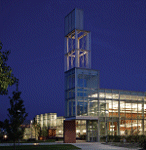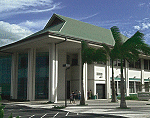The T-Shaped Graduate
These days, even if community colleges hit their graduation goals, the jobs outlook for their graduates can be grim.
- By Rama Ramaswami
- 12/01/09
As President Obama said in advance remarks about the American Graduation Initiative: "[T]he hard truth is that some of the jobs that have been lost in the auto industry and elsewhere won't be coming back. And that only underscores the importance of generating new businesses and industries to replace the ones we've lost, and of preparing our workers to fill the jobs they create." The initiative calls for community colleges to "build partnerships with businesses and the workforce investment system to create career pathways."Some colleges are ahead of the game, partnering with technology companies in innovative programs that seek to teach students the flexible, analytical, and interactive skills that businesses worldwide are looking for now and in the coming years. Here we profile three programs that are redefining "jobs training" for a new economy.

Metropolitan Community College's South Omaha Campus
"ONE OF THE THINGS our customers are asking for are 'T-shaped' students, who are steeped in both technology and business," says Mark Hanny, IBM's vice president of independent software vendor alliances and developer relations and manager of the IBM Academic Initiative, a program that provides access to IBM software and courseware materials for teaching, learning, and non-commercial research. The concept of T-shaped people was coined by product-design firm Ideoto describe workers who have a principal skill (the vertical leg of the T) but who can also branch out (the horizontal bar of the T) into other disciplines and handle them well. Businesses today, Hanny says, are "looking for people who understand both the technology and the analytics and who can help companies leverage information to better serve their clients."
That's the thinking behind IBM's recently announced partnership with Omaha-based Metropolitan Community College to develop a two-year, first-of-its-kind degree in green data center management, using IBM hardware, software, and online skills-training resources. Beginning this month, all courses in MCC's 36-credit green data center management track will be offered online, with virtual access to an on-campus physical data center whose construction is almost complete. Funded through a three-year, $1.8 million grant from the US Department of Labor, the data center operates on IBM Power Systems servers running AIX, IBM iSeries, and Linux environments.
Understanding green data center management has implications that go beyond IT, Hanny says. "The program is about more than running a data center. It helps you understand how companies are putting data centers at the center of their strategies." Along with traditional technical courses, the curriculum includes courses in infrastructure, project management, and information analysis.
This holistic approach to IT is a major departure from previous instructional models, according to MCC's dean of information technology and eLearning, Thomas Pensabene: "The new partnership has changed our academic thinking. We think differently about programming and computing. Originally, all we did with IBM was very traditional-- they mostly supplied the equipment." The green data center, he says, is a giant leap forward from the days when computer networking was "just a few programmers in the basement." Now, using IBM's course tools and green data center technologies, instructors teach networking and other IT components in the larger context of engineering, sustainability, and business, giving students the versatile education that allows them flexibility in their choice of jobs and employers. "We wouldn't even be approaching this stage if it weren't for the partnership with IBM," Pensabene says.
The T-shaped graduate also is very much on the mind of Cisco Systems, whose Cisco Networking Academy, a partnership with educational institutions launched in 1997, operates in 160 countries and nearly half of all community colleges in the US. Cisco has invested a sizable $300 million in the program, which teaches students how to design, build, and troubleshoot computer networks. Lately, Cisco has been working with colleges to enrich and expand the scope of the partnership. In July 2009, the technology company launched a pilot program called the Workforce Retraining Initiative (WRI) at the 21 community college and university locations in Michigan where the Networking Academy curriculum is offered. A joint private sector-government effort to help retrain American workers, the WRI will include a new healthcare IT course (Michigan's healthcare jobs are expected to increase) as well as network-security and broadband-technology training.
Caroll McGillin, the Networking Academy's business development manager, explains that Cisco "wanted to address a core need for educators-- how do they stay current and relevant? How do they bring to market the kinds of courses students need?"
The answer, Cisco realized, lay in instruction that equipped students not just for IT but for the wider world beyond. "About two and a half years ago, as we looked at our global learners, we realized that we already had the techies," McGillin says. "Now what's really exciting to see is that we're getting Cisco integrated with engineering, telecom, and business programs. Because the internet has become ubiquitous in every industry, we're seeing a very innovative use of our program in colleges-- they're teaching the business context as well as the engineering context."
Echoing IBM's Hanny, McGillin notes that Cisco's clients demand more than narrow technical expertise from their hires. "What we're hearing is that they look for a combination of technical skills, 'soft' skills, and critical-thinking and collaboration skills."

Over the last 10 years, unemployment for adults (age 25 and over) with some college or an associate's degree has skyrocketed. Community colleges are partnering with corporations to redefine job training for such an uncertain market. (Data source: Bureau of Labor Statistics)
Hands-on Learning
All this doesn't mean that traditional technical instruction is given short shrift. If anything, it's more intense than ever. At Florida State College in Jacksonville, which has more than 80,000 students enrolled, the Cisco Networking Academy is by far the most popular component of the networking degree program, says Ernie Friend, FSCJ's director of academic systems. (Note: Until Aug. 1, 2009, FSCJ was called Florida Community College at Jacksonville). Friend attributes this to the highly interactive and hands-on nature of the program. For example, in a class of four hours, just 45 minutes is spent on lectures, he says; the remainder goes to working with the equipment. This practical experience makes Cisco Networking Academy graduates attractive to employers-- no mean achievement in an economy in which jobs are scarce. Friend points to some notable examples where the Cisco program has made all the difference. In one case, FSCJ was working with a staffing agency to provide technicians trained on Cisco infrastructure for a large cable company. The latter did not usually give credence to community college graduates, but was so impressed with the hands-on experience of FSCJ students that it is expected to hire two or three of them every month. In another case, an international bank was working with an outsourcing firm to roll out 10,000 Cisco IP phones. Struck by the thoroughness of the Networking Academy curriculum, the outsourcing firm has hired 40 FSCJ students over the past three or four years. "Ninety-nine percent of our students are able to get jobs," Friend says. "A lot of that goes back to the Academy training."
The close partnership with Cisco-- and the positive results it produces-- has turned Friend into something of a salesman for the program. "In a lot of cases people in education don't think they need to be in sales," he says. "But what I'm selling to the business community is confidence in our graduates. I send an e-mail to new companies and try to make a connection with them. I also work with chambers of commerce and talk about what we do. Once the connection is made, the next thing is to build relationships. There are very few cases where that hasn't produced internships, if not jobs."
That level of relevancy to the workplace is the cornerstone of the Networking Academy, says McGillin. Cisco content experts develop the curriculum alongside community college instructors. Cisco Packet Tracer, a network-simulation program, complements the curriculum by allowing students to build, experiment with, and troubleshoot virtual networks so they can learn the critical decision-making and problem-solving skills essential to actual business settings.
Walking the Walk
 "I THINK THAT the Graduation Initiative really has to do with not simply graduating more students, but getting students connected with jobs once they graduate. For us, we know it's the living-wage careers that will allow our graduates of Maui Community College to continue to live and work on Maui and in Hawaii. It's about economic recovery grounded in some kind of efficiency, adding value via our tech advantage in this country.When you've got the NSF involved,you've got all of the threshold technologies-- nanotech, robotics, and every facet of science that could plumb resources... .Ultimately, we'd want to get ahead of the curve on the kinds of technologies that would add value to whatever kind of science,healthcare, or business sector we might be looking at. If we can create a well informed, competent, math and science-grounded workforce that's technology-oriented and graduating at higher rates, then we're going to have the kind of workforce that will fill vacancies and opportunities as they emerge. And I would be surprised if the American Graduation Initiative didn't [do] something to invite business/public-sector partnerships."
"I THINK THAT the Graduation Initiative really has to do with not simply graduating more students, but getting students connected with jobs once they graduate. For us, we know it's the living-wage careers that will allow our graduates of Maui Community College to continue to live and work on Maui and in Hawaii. It's about economic recovery grounded in some kind of efficiency, adding value via our tech advantage in this country.When you've got the NSF involved,you've got all of the threshold technologies-- nanotech, robotics, and every facet of science that could plumb resources... .Ultimately, we'd want to get ahead of the curve on the kinds of technologies that would add value to whatever kind of science,healthcare, or business sector we might be looking at. If we can create a well informed, competent, math and science-grounded workforce that's technology-oriented and graduating at higher rates, then we're going to have the kind of workforce that will fill vacancies and opportunities as they emerge. And I would be surprised if the American Graduation Initiative didn't [do] something to invite business/public-sector partnerships."
-- Clyde Sakamoto, chancellor, Maui Community College
A Workplace Focus
Like the FSCJ-Cisco partnership, the IBM-MCC green data center program also is intensely focused on the workplace. "This is the model-- it's problem-based learning, with realistic, messy problems that students solve by working in teams," says MCC's Pensabene. "You want to get away from lectures. For example, in one networking project we gave the group four empty rooms and asked them to design the space."
By encouraging creativity and original thinking, the program prepares students to apply their technical knowledge to a variety of sectors, in Hanny's view. "They're not limited to a traditional IT firm; they can work in all kinds of industries, as all businesses are now tech-savvy."
Hanny notes that IBM is now working on green data centers with universities in Australia and the UK. "All of this flows into the whole idea of a smarter planet-- how you can leverage information to save money and help customers," he says. "We still work in traditional computer science, but more and more we're going outside of it."
In a sense, by going beyond conventional boundaries, the new academic business partnerships are "disruptive," Hanny says, referring to the term used in business to describe breakthroughs in technology and innovation. "Technology was a part of many disruptive models. It is a key differentiator."